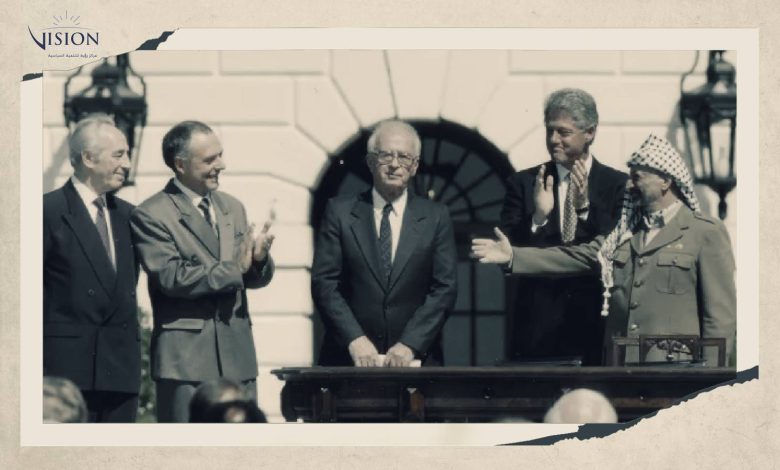On the Genius of Oslo and the Transformations in Palestinian Society

Ahmed Atawna
The centers Vision for Political Development and “Al-Sharq” for Strategic Studies recently concluded their fourth conference in Istanbul, within the framework of a research project examining the post-Oslo transformations in Palestinian society. The conference featured participation by researchers, academics, and political figures from the entire Palestinian geography, including areas of diaspora and refuge, and encompassing all strata and political trends of Palestinian society. The project, which addressed the most prolonged phase in the history of contemporary national struggle, consisted of four academic conferences. Over 120 Palestinian and Arab academics, experts, and politicians took part, contributing more than 70 scholarly papers.
The first conference addressed the transformations in political variables and Palestinian institutions post-Oslo Agreement. It encompassed Palestinian political institutions, parties, and factions, as well as non-partisan variables and civil society within Palestinian society. The second conference delved into the transformations in methods of struggle, resistance, and Palestinian identity, including shifts in the relationship between popular Palestinian incubators and the Palestinian struggle after Oslo. The conference also explored the boundaries between collective and sub-identities and examined various forms of armed struggle, resistance movements, or what can be termed as new forms of struggle.
- The inaugural conference delved into the transformations in the political variables and institutions of Palestine following the Oslo Agreement. This included a comprehensive analysis of Palestinian political establishments, parties, and factions, as well as the non-partisan variables and civil society within Palestinian societal constructs.
- The second conference embarked on an examination of the metamorphoses within methods of struggle, resistance, and Palestinian identity. It included an analysis of the shifts in the relationships between the popular Palestinian incubators and the Palestinian struggle post-Oslo, probing the boundaries between collective and sub-identities, as well as the contours of armed struggle and resistance movements (or what may be termed as emergent forms of struggle).
- The third conference engaged in an analytical dissection of the political shifts affecting the Palestinian question during the Oslo period. It probed into transformations within diverse political contexts: Palestinian, Arab, Islamic, international, and even the Israeli scenario.
- Meanwhile, the fourth conference embarked on a meticulous examination of the post-Oslo Agreement alterations within the Palestinian economy and society, delving into the intricate dynamics across various geographies, sectors, and multifaceted dimensions. The constraints of this article preclude an exhaustive exploration of the themes and subjects addressed within these conferences.
The dialogues within were characterized by their intellectual richness and depth, traversing the terrain of concepts, strategic initiatives, and policy directions. For those with a specialized interest in the matter, further details can be located on the online platforms of the two organizing centers, including the inaugural publication they have issued. In the ensuing segments, however, attention will be directed toward illuminating the salient conclusions arrived at by expert researchers, particularly focusing on the facets associated with the Oslo Accords and the subsequent phase, including the following:
First: The “Genius” of Oslo
This term has been repeatedly utilized by various specialists and experts to articulate the magnitude of the impact wrought by the Oslo Agreement on the Palestinian condition. It illuminates the complexity that the agreement added to the Palestinian scene and the extent of the Zionist investment in this accord. This investment serves the continuity and consolidation of the occupation, relieving it of many burdens without rendering any cost to the Palestinians, leading some to describe the occupation as a “five-star occupation.”
The Oslo Agreement indeed exempted the occupation from the obligation to manage the affairs of the occupied people “administratively, economically, socially, and security-wise,” placing all of these responsibilities on the shoulders of a Palestinian Authority devoid of sovereignty and power. Simultaneously, the agreement maintained the military and security control of the occupation over all Palestinian lands and the Palestinian people.
In other words, the Zionist entity practices occupation without officially or politically exerting it at the same time. It means that it exercises its occupation over the Palestinian people and land on the ground without formally practicing it in front of the world. The Palestinian Authority has constituted a protective barrier for the occupation and, in many cases, has acted as an intermediary between it and the Palestinian people.
In addition to the aforementioned, the Oslo Agreement engendered mechanisms and realities on the ground that have shackled all the political and economic components of the Palestinian cause. To date, it has obstructed the ability to escape or rebel against this agreement. Neither the Authority with its parties and components nor the resistance factions that reject the agreement are capable of overcoming it. They have been unable to construct a new Palestinian state capable of confronting the occupation, nor achieve any of the national rights independently of the obligations engendered by the Oslo Accords.
These agreements have woven a complex web that entangles various political and economic aspects, creating a scenario where both traditional and resistant forces find themselves unable to redefine or restructure the Palestinian cause in opposition to the established Oslo framework. It underscores a challenging reality where the agreement’s legacy continues to influence and constrain the Palestinian strategic and tactical options in their struggle for self-determination.
Second: A Renewed Palestinian Diaspora
The Oslo Agreement imposed a national and political reality that constituted, and continues to present, a challenge to the Palestinian national movement and the Palestinian national project. This challenge is felt both in the context of political institutions, party structures, and interrelationships, and in terms of political programs and projects. The agreement has effectively re-fragmented and dispersed the Palestinians, neutralizing large blocs from the national struggle.
Specifically, the Oslo Agreement isolated the Palestinian diaspora, which had previously led the national movement. It also marginalized the Palestinians of 1948 by abandoning their identification as part of the Palestinian people with their national struggle, following the recognition of Israel. This has led to a renewed fragmentation of the Palestinian community, both within the territories and in the diaspora.
The implications of this fragmentation are multifaceted, affecting the coherence of the national struggle, the unity of purpose, and the collective identity of the Palestinian people. The agreement’s redefining of relationships within the Palestinian community has led to divisions that continue to challenge the cohesive pursuit of Palestinian rights and aspirations. It underscores the complex interplay of identity, political alignment, and the struggle for self-determination in the contemporary Palestinian context.
Additionally, the size and role of a significant number of Palestinian factions have shrunk over the past three decades, and the presence and effectiveness of political institutions have weakened, becoming trivialized. This decline is due to the diminishment of the space for national struggle in favor of peaceful political action.
The political landscape has become so fragmented that the national effort seems to be undermining itself, instead of functioning within a framework of positive and constructive diversity and integration. There is no unity in representation, no unifying and effective political institutions, and no coordination in performance. This fragmentation is not confined to the political division resulting from Oslo, which subsequently evolved into a geographical and institutional division between the West Bank and the Gaza Strip. Another division has emerged concerning the nature of the national project, including its vision, programs, and working mechanisms. This has led to each faction having its unique definition, and even the currents within a single faction have their particular interpretations.
This complex landscape reflects the profound challenges that the Palestinian political system faces in articulating a coherent, unified strategy. The erosion of trust between different factions, the absence of shared institutions, and the lack of a common vision all serve to exacerbate internal tensions and obstruct the pursuit of collective goals. The fragmentation following the Oslo Accords thus represents a multifaceted obstacle to the realization of the Palestinian national aspirations, highlighting the need for greater coherence, collaboration, and alignment within the Palestinian political landscape.
Third: Profound Impact and Structural Transformations
A series of profound transformations has emerged in Palestinian society, affecting its various aspects and bringing about changes in its composition, performance, and political, economic, social, and struggle-related behavior. These transformations have left their mark on the course of the Palestinian issue and the nature and role of the Palestinian national movement in its various components. They have also revealed a set of internal Palestinian contradictions that have reflected on Palestinian performance at more than one level. Economic, political, social, and security categories have grown, and their interests, and even their very existence, have become linked to the Oslo Accords and its institutions, as well as to the nature of the relationship with the occupation and the manner of engaging and confronting it. To the extent that the existence and stability of the relationship with the occupation have become an objective condition for the existence of some of these sectors and institutions.
Fourth: Negative Stability in the International Environment
The Palestinian political reality, along with the divergence in its interpretation and assessment, coincides with the continuing imbalance in the international power dynamics. The United States, wholly biased towards the Zionist entity, has continued to singularly stand as the great power sponsoring what is known as the peace process and the Palestinian issue. Although some Eastern powers have begun to move practically to carve out space for themselves as great powers competing and challenging U.S. dominance, this has been greatly manifested in the Russian-Ukrainian war that broke out at the beginning of last year. However, a fundamental change does not seem likely to occur in this picture over the coming few years. Even the powers that are qualified to compete with the United States on the international political scene do not have positions that can make a substantial difference concerning the Palestinian issue; China, Russia, and India are countries friendly to the Zionist entity, and they are closer to adopting its positions rather than supporting Palestinian rights.
Fifth: Collapse in the Regional Environment
The Palestinian reality also intersects with regional conditions that tend to favor Israel and enhance its regional role; the region, with its Arab and Islamic states, has been engulfed in the throes of sectarian, doctrinal, and civil wars. This is a result of the confrontation of the Arab Spring by totalitarian regimes, negative foreign interventions, recourse to narrow sectarian and ideological interests, which have thwarted the hopes and ambitions of the peoples for freedom and change. The Arab and Islamic states have lined up against each other, and the change movements and their supporters have failed to preserve the revolutions that succeeded in toppling some of the totalitarian regimes. Meanwhile, the United States, benefiting from some political mistakes, has succeeded in presenting Israel as an ally to the countries concerned about Iranian influence and the Arab Spring, the outlines of which have begun to appear through the development of secret and public relations between Israel and a number of Arab countries.
Sixth: The Reproduction of Zionism Itself
These developments in the national, regional, and international reality have been accompanied by a relentless change in the Zionist political landscape. The most extremist right-wing forces have continued to advance at the expense of the center and extreme right, to the point that political alliances to form the government – as in the current government – are made between the extreme right and the more extreme right. This has led to the transformation of the occupying state into a religious, fascist, and racist state. The insistence on defining the state entity as Jewish, the adoption of the racist Nationality Law, the continuation of building the racist separation wall, and the reinforcement of the image of the apartheid state; all of this has led to the end of political approaches that lasted for decades, and put an end to many perceptions and political ideas for dealing with this entity. It has greatly reduced the chance of promoting it in the region by its supporters as a modern and advanced democratic state. Progress in some areas of science cannot cover up the features of fascism and racism that have dominated it, which could assist the Palestinians in their national project if they manage to properly exploit these data.
Seventh: “Oslo” as a New Model of Colonialism
In the final session of the recent conference, one of the Palestinian academics, Dr. Khaled Al-Haroub, introduced a concept worthy of contemplation and discussion. He posited that “Oslo” has ultimately ceased to be an agreement aimed at resolving the Palestinian issue or establishing an independent, sovereign Palestinian state. Instead, it has emerged as a new paradigm for substitutional colonial settlement. Addressing and studying “Oslo” within this framework and context might enable the Palestinians to craft strategies, policies, and visions for confronting the occupation and realizing Palestinian rights. It could also help them escape the impasse of “Oslo” and initiate a fresh national phase that reinstates the dignity of the Palestinian cause and the Palestinian national movement. This is particularly pertinent given that the vital elements of the Palestinian people, especially the youth, have not wholly succumbed to “Oslo” and its ramifications. Instead, they have rebelled against it, returning to the initial stance of opposing the occupation, anchored in the understanding that Palestine, in its entirety, is a singular entity, and the Palestinian people, in all its various congregations, wherever they may be, constitute one people with a unified cause.





